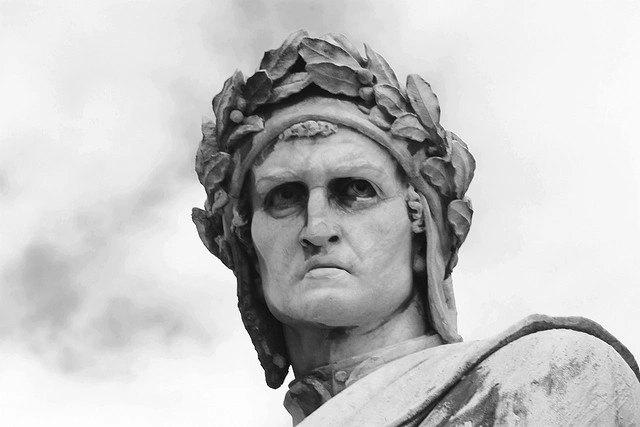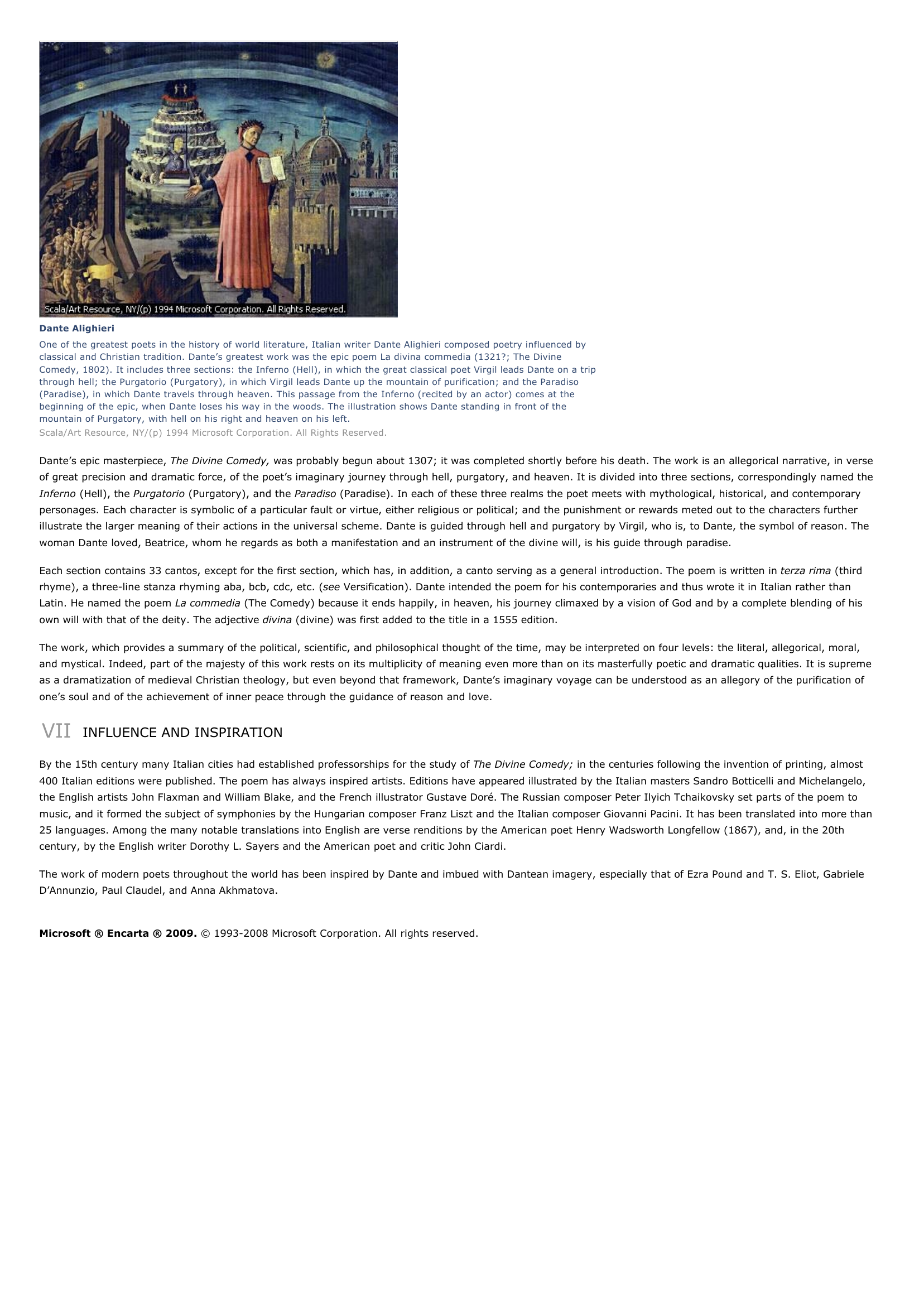Dante Alighieri I INTRODUCTION Dante Alighieri (1265-1321), Italian poet, and one of the supreme figures of world literature, who was admired for the depth of his spiritual vision and for the range of his intellectual accomplishment.
Publié le 12/05/2013

Extrait du document


«
Dante AlighieriOne of the greatest poets in the history of world literature, Italian writer Dante Alighieri composed poetry influenced byclassical and Christian tradition.
Dante’s greatest work was the epic poem La divina commedia (1321?; The DivineComedy, 1802).
It includes three sections: the Inferno (Hell), in which the great classical poet Virgil leads Dante on a tripthrough hell; the Purgatorio (Purgatory), in which Virgil leads Dante up the mountain of purification; and the Paradiso(Paradise), in which Dante travels through heaven.
This passage from the Inferno (recited by an actor) comes at thebeginning of the epic, when Dante loses his way in the woods.
The illustration shows Dante standing in front of themountain of Purgatory, with hell on his right and heaven on his left.Scala/Art Resource, NY/(p) 1994 Microsoft Corporation.
All Rights Reserved.
Dante’s epic masterpiece, The Divine Comedy, was probably begun about 1307; it was completed shortly before his death.
The work is an allegorical narrative, in verse of great precision and dramatic force, of the poet’s imaginary journey through hell, purgatory, and heaven.
It is divided into three sections, correspondingly named theInferno (Hell), the Purgatorio (Purgatory), and the Paradiso (Paradise).
In each of these three realms the poet meets with mythological, historical, and contemporary personages.
Each character is symbolic of a particular fault or virtue, either religious or political; and the punishment or rewards meted out to the characters furtherillustrate the larger meaning of their actions in the universal scheme.
Dante is guided through hell and purgatory by Virgil, who is, to Dante, the symbol of reason.
Thewoman Dante loved, Beatrice, whom he regards as both a manifestation and an instrument of the divine will, is his guide through paradise.
Each section contains 33 cantos, except for the first section, which has, in addition, a canto serving as a general introduction.
The poem is written in terza rima (third rhyme), a three-line stanza rhyming aba, bcb, cdc, etc.
( see Versification).
Dante intended the poem for his contemporaries and thus wrote it in Italian rather than Latin.
He named the poem La commedia (The Comedy) because it ends happily, in heaven, his journey climaxed by a vision of God and by a complete blending of his own will with that of the deity.
The adjective divina (divine) was first added to the title in a 1555 edition.
The work, which provides a summary of the political, scientific, and philosophical thought of the time, may be interpreted on four levels: the literal, allegorical, moral,and mystical.
Indeed, part of the majesty of this work rests on its multiplicity of meaning even more than on its masterfully poetic and dramatic qualities.
It is supremeas a dramatization of medieval Christian theology, but even beyond that framework, Dante’s imaginary voyage can be understood as an allegory of the purification ofone’s soul and of the achievement of inner peace through the guidance of reason and love.
VII INFLUENCE AND INSPIRATION
By the 15th century many Italian cities had established professorships for the study of The Divine Comedy; in the centuries following the invention of printing, almost 400 Italian editions were published.
The poem has always inspired artists.
Editions have appeared illustrated by the Italian masters Sandro Botticelli and Michelangelo,the English artists John Flaxman and William Blake, and the French illustrator Gustave Doré.
The Russian composer Peter Ilyich Tchaikovsky set parts of the poem tomusic, and it formed the subject of symphonies by the Hungarian composer Franz Liszt and the Italian composer Giovanni Pacini.
It has been translated into more than25 languages.
Among the many notable translations into English are verse renditions by the American poet Henry Wadsworth Longfellow (1867), and, in the 20thcentury, by the English writer Dorothy L.
Sayers and the American poet and critic John Ciardi.
The work of modern poets throughout the world has been inspired by Dante and imbued with Dantean imagery, especially that of Ezra Pound and T.
S.
Eliot, GabrieleD’Annunzio, Paul Claudel, and Anna Akhmatova.
Microsoft ® Encarta ® 2009. © 1993-2008 Microsoft Corporation.
All rights reserved..
»
↓↓↓ APERÇU DU DOCUMENT ↓↓↓
Liens utiles
- Luciano PavarottiIINTRODUCTIONLuciano PavarottiRenowned Italian tenor Luciano Pavarotti was known for his mastery of the highest notes of a tenor's range and for hisjovial personality, which helped him earn a wide popular following.
- William Blake I INTRODUCTION William Blake (1757-1827), English poet, painter, and engraver, who created an unusual form of illustrated verse; his poetry, inspired by mystical vision, is among the most original, lyric, and prophetic in the language.
- Musical I INTRODUCTION George Gershwin American pianist, songwriter, and composer George Gershwin was one of the most important figures in popular song in the 1920s and 1930s.
- William Shakespeare I INTRODUCTION William Shakespeare English playwright and poet William Shakespeare, who lived in the late 1500s and early 1600s, is regarded as the greatest dramatist in the history of English literature.
- Confucius I INTRODUCTION Confucius (551 or 552-479 BC), Chinese philosopher and educator, one of the most important individuals in Chinese history, and one of the most influential figures in world history.

































